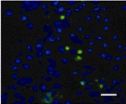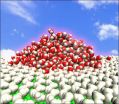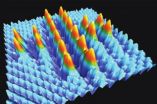(Press-News.org) The over-expression of α-synuclein is a major factor in the death of dopaminergic neurons in a methamphetamine-induced model of Parkinson's disease (PD). Dr. Huijun Wang, School of Basic Medical Sciences, Southern Medical University, China and his team injected α-synuclein-shRNA lentivirus stereotaxically into the right striatum of experimental rats to inhibit α-synuclein mRNA and protein expression. Results showed that after α-synuclein knockdown, the depression manifestations of PD rats were reduced, striatal dopamine and tyrosine hydroxylase levels as well as superoxide dismutase activity were significantly increased, but the levels of reactive oxygen species, malondialdehyde, nitric oxide synthase and nitrogen monoxide were decreased, and simultaneously, the number of apoptotic cells in the striatum was significantly decreased. The authors considered α-synuclein has the capacity to reverse methamphetamine-induced apoptosis of dopaminergic neurons in the rat striatum by inhibiting oxidative stress and improving dopaminergic system function. Related results were published in Neural Regeneration Research (Vol. 9, No. 9, 2014).
Article: " Protective effect of alpha-synuclein knockdown on methamphetamine-induced neurotoxicity in dopaminergic neurons," by Yunchun Tai1, Ling Chen1, Enping Huang1, Chao Liu1, 2, Xingyi Yang1, Pingming Qiu1, Huijun Wang1 (1 Department of Forensic Medicine, School of Basic Medical Sciences, Southern Medical University, Guangzhou, Guangdong Province, China; 2 Guangzhou Forensic Science Institute, Guangzhou, Guangdong Province, China)
Tai YC, Chen L, Huang EP, Liu C, Yang XY, Qiu PM, Wang HJ. Protective effect of alpha-synuclein knockdown on methamphetamine-induced neurotoxicity in dopaminergic neurons. Neural Regen Res. 2014;9(9):951-958.
Contact: Meng Zhao
eic@nrren.org
86-138-049-98773
Neural Regeneration Research
http://www.nrronline.org/
INFORMATION: END
Protective effect of α-synuclein knockdown on dopaminergic neurons
2014-07-15
ELSE PRESS RELEASES FROM THIS DATE:
Shanghai scientists challenge classical phenomenon that water always completely wets water
2014-07-15
The molecular scale behavior of water at a solid/liquid interface holds fundamental significance in a diverse set of technical and scientific contexts, ranging from the efficiency of oil mining to the activity of biological molecules. Recently, it has become recognized that both the physical interactions and the surface morphology have significant impact on the behavior of interfacial water, including the water structures and wetting properties of the surface.
In a new review, Chunlei Wang, Yizhou Yang and Haiping Fang of the Shanghai Institute of Applied Physics report ...
SWI assesses signal strength in different brain regions after acute hemorrhagic anemia
2014-07-15
Acute hemorrhagic anemia can decrease blood flow and oxygen supply to brain, and affect its physiological function. Detecting changes in brain function in patients with acute hemorrhagic anemia is helpful for preventing neurological complications and evaluating therapeutic effects. Susceptibility-weighted imaging (SWI) imaging is a novel, non-invasive method for detecting changes in cerebral oxygen levels that may provide more detailed information regarding cerebral blood flow in patients with hemorrhage. Dr. Jun Xia, Second People's Hospital of Shenzhen City, First Affiliated ...
Taking B vitamins won't prevent Alzheimer's disease
2014-07-15
Taking B vitamins doesn't slow mental decline as we age, nor is it likely to prevent Alzheimer's disease, conclude Oxford University researchers who have assembled all the best clinical trial data involving 22,000 people to offer a final answer on this debate.
High levels in the blood of a compound called homocysteine have been found in people with Alzheimer's disease, and people with higher levels of homocysteine have been shown to be at increased risk of Alzheimer's disease. Taking folic acid and vitamin B-12 are known to lower levels of homocysteine in the body, so ...
How strongly does tissue decelerate the therapeutic heavy ion beam?
2014-07-15
Irradiation with heavy ions is suitable in particular for patients suffering from cancer with tumours which are difficult to access, for example in the brain. These particles hardly damage the penetrated tissue, but can be used in such a way that they deliver their maximum energy only directly at the target: the tumour. Research in this relatively new therapy method is focussed again and again on the exact dosing: how must the radiation parameters be set in order to destroy the cancerous cells "on the spot" with as low a damage as possible to the surrounding tissue? The ...
New hope for treatment of Alzheimer's disease
2014-07-15
Montreal, July 15 2014 - Judes Poirier, PhD, C.Q., from the Douglas Mental Health Institute and McGill University in Montréal (Canada) and his team have discovered that a relatively frequent genetic variant actually conveys significant protection against the common form of Alzheimer's disease and can delay the onset of the disease by as much as 4 years. This discovery opens new avenues for treatment against this devastating disease.
Dr. Poirier announced his findings as the annual Alzheimer's Association International Conference was taking place in Copenhagen. This large-scale ...
Smallest Swiss cross -- Made of 20 single atoms
2014-07-15
The manipulation of atoms has reached a new level: Together with teams from Finland and Japan, physicists from the University of Basel were able to place 20 single atoms on a fully insulated surface at room temperature to form the smallest "Swiss cross", thus taking a big step towards next generation atomic-scale storage devices. The academic journal Nature Communications has published their results.
Ever since the 1990s, physicists have been able to directly control surface structures by moving and positioning single atoms to certain atomic sites. A number of atomic ...
Cholesterol activates signaling pathway that promotes cancer
2014-07-15
Everyone knows that cholesterol, at least the bad kind, can cause heart disease and hardening of the arteries. Now, researchers at the University of Illinois at Chicago describe a new role for cholesterol in the activation of a cellular signaling pathway that has been linked to cancer.
The finding is reported in Nature Communications.
Cells employ thousands of signaling pathways to conduct their functions. Canonical Wnt signaling is a pathway that promotes cell growth and division and is most active in embryonic cells during development. Overactivity of this signaling ...
Researchers assess emergency radiology response after Boston Marathon bombings
2014-07-15
OAK BROOK, Ill. – An after-action review of the Brigham and Women's Hospital emergency radiology response to the Boston Marathon bombings highlights the crucial role medical imaging plays in emergency situations and ways in which radiology departments can improve their preparedness for mass casualty events. The new study is published online in the journal Radiology.
"It's important to analyze our response to events like the Boston Marathon bombing to identify opportunities for improvement in our institutional emergency operations plan," said senior author Aaron Sodickson ...
No anti-clotting treatment needed for most kids undergoing spine surgeries
2014-07-15
Blood clots occur so rarely in children undergoing spine operations that most patients require nothing more than vigilant monitoring after surgery and should be spared risky and costly anti-clotting medications, according to a new Johns Hopkins Children's Center study.
Because clotting risk in children is poorly understood, treatment guidelines are largely absent, leaving doctors caring for pediatric patients at a loss on whom to treat and when.
The Johns Hopkins' team findings, published online July 15 in the journal Spine, narrow down the pool of high-risk patients ...
Little too late: Researchers identify disease that may have plagued 700-year-old skeleton
2014-07-15
European researchers have recovered a genome of the bacterium Brucella melitensis from a 700-year-old skeleton found in the ruins of a Medieval Italian village.
Reporting this week in mBio®, the online open-access journal of the American Society for Microbiology, the authors describe using a technique called shotgun metagenomics to sequence DNA from a calcified nodule in the pelvic region of a middle-aged male skeleton excavated from the settlement of Geridu in Sardinia, an island off the coast of Italy. Geridu is thought to have been abandoned in the late 14th century. ...





